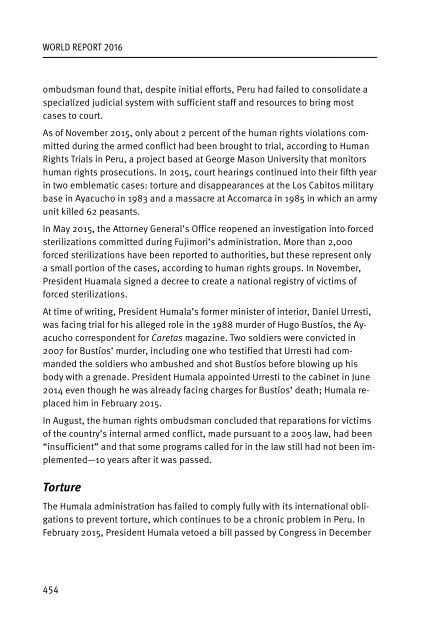Create successful ePaper yourself
Turn your PDF publications into a flip-book with our unique Google optimized e-Paper software.
WORLD REPORT 2016<br />
HUMAN RIGHTS WATCH<br />
ombudsman found that, despite initial efforts, Peru had failed to consolidate a<br />
specialized judicial system with sufficient staff and resources to bring most<br />
cases to court.<br />
As of November 2015, only about 2 percent of the human rights violations committed<br />
during the armed conflict had been brought to trial, according to Human<br />
Rights Trials in Peru, a project based at George Mason University that monitors<br />
human rights prosecutions. In 2015, court hearings continued into their fifth year<br />
in two emblematic cases: torture and disappearances at the Los Cabitos military<br />
base in Ayacucho in 1983 and a massacre at Accomarca in 1985 in which an army<br />
unit killed 62 peasants.<br />
In May 2015, the Attorney General’s Office reopened an investigation into forced<br />
sterilizations committed during Fujimori’s administration. More than 2,000<br />
forced sterilizations have been reported to authorities, but these represent only<br />
a small portion of the cases, according to human rights groups. In November,<br />
President Huamala signed a decree to create a national registry of victims of<br />
forced sterilizations.<br />
At time of writing, President Humala’s former minister of interior, Daniel Urresti,<br />
was facing trial for his alleged role in the 1988 murder of Hugo Bustíos, the Ayacucho<br />
correspondent for Caretas magazine. Two soldiers were convicted in<br />
2007 for Bustíos’ murder, including one who testified that Urresti had commanded<br />
the soldiers who ambushed and shot Bustíos before blowing up his<br />
body with a grenade. President Humala appointed Urresti to the cabinet in June<br />
2014 even though he was already facing charges for Bustíos’ death; Humala replaced<br />
him in February 2015.<br />
In August, the human rights ombudsman concluded that reparations for victims<br />
of the country’s internal armed conflict, made pursuant to a 2005 law, had been<br />
“insufficient” and that some programs called for in the law still had not been implemented—10<br />
years after it was passed.<br />
Torture<br />
The Humala administration has failed to comply fully with its international obligations<br />
to prevent torture, which continues to be a chronic problem in Peru. In<br />
February 2015, President Humala vetoed a bill passed by Congress in December<br />
2014 that would have created the National Preventive Mechanism Against Torture.<br />
He argued that the mechanism’s costs had not been included in the 2015<br />
national budget. The bill was returned to Congress. Under the Optional Protocol<br />
to the Convention against Torture and Other Cruel, Inhuman or Degrading Treatment<br />
(OPCAT), which Peru ratified in 2006, the country should have implemented<br />
a National Preventive Mechanism Against Torture by 2007.<br />
Freedom of Expression<br />
Journalists investigating corruption by regional government officials, mayors,<br />
and business people are frequent targets of physical attack, threats, and criminal<br />
defamation suits.<br />
In March 2015, two unidentified men shot bullets at the building of a local TV<br />
channel, Canal 21, in the municipality of Vista Alegre in the southwestern<br />
province of Nazca. The owner of the channel said that the attack occurred soon<br />
after he had aired allegations that the local mayor had made death threats<br />
against two residents of Vista Alegre.<br />
In May 2015, two journalists from the TV channel Cable Vision said they had received<br />
several anonymous threats that the police would detain them after they<br />
reported on the misuse of force by policemen during protests against the Tía<br />
María mining project in the southwestern province of Islay.<br />
Women’s Rights<br />
Women and girls in Peru remain at high risk of gender-based violence. In August,<br />
the Minister of Women’s Affairs reported 96 cases of “femicide” (the killing of a<br />
woman in certain contexts, including of domestic violence and gender-based<br />
discrimination) in 2014, and 52 between January and July 2015.<br />
In September, Congress passed a law that provides for comprehensive measures<br />
to prevent punish and eradicate violence against women. The law builds on existing<br />
judicial measures to protect women at risk, and mandates the creation of<br />
shelters to provide temporary refuge from abuse. The Committee on the Elimination<br />
of Discrimination Against Women, in its review of Peru in July 2014, had<br />
called on the country to pass a law against gender-based violence.<br />
454<br />
455


